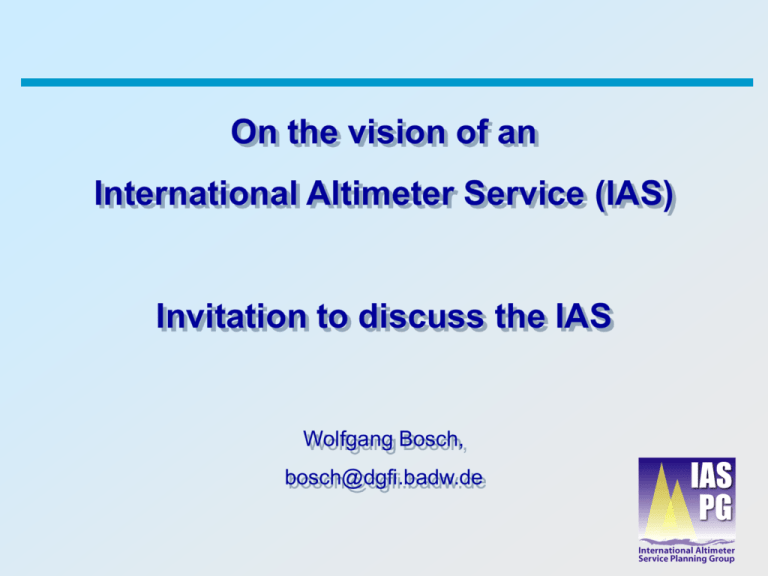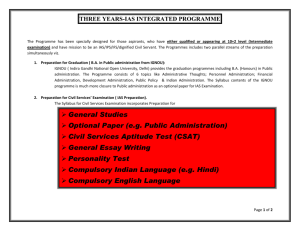BOSCH-IAS - CSIRO Marine and Atmospheric Research
advertisement

On the vision of an International Altimeter Service (IAS) Invitation to discuss the IAS Wolfgang Bosch, bosch@dgfi.badw.de Rationale for IAS (top-down) • Focus on Global Earth Observing Systems (GEOS) to be coordinated by GEOSS, a system of systems • G4OS: – – – – GOOS for the Ocean GCOS for Climate GTOS for the terrestrial Component, and GGOS for the geodetic component • Due to its many interdisciplinary applications for oceanography, marine geophysics, the Earth gravity field, the Earth rotation, … satellite altimetry has to be a mandatory element of GEOS OST Science Team Meeting, Hobart, March 12-15, 2007 2 Rationale for IAS (bottom-up) • There are already (many and excellent) services for satellite altimetry, but in spite of that users are sometimes lost in hyperspace – Differences between MGDR-C (CNES) and MGB (NASA) known? – Where can users find the most reliable estimate of range biases of Jason1 or ENVISAT? – Why are all users forced to perform their own upgrade for new orbits (due to improved gravity fields) and new correction models (tides, SSB, wet tropo)? – Should a user take KMS04 or CLS01 or DSNC07? – Why are there different formats for the marine gravity data ( S&S and DNSC)? – Where to get informed about different estimates of the Mean Dynamic Ocean Topography? 3 OST Science Team Meeting, Hobart, March 12-15, 2007 IGS – a model for IAS ? • Motivation for IAS derived from IGS (International Global Navigation Satellite Systems Service), successfully realised – By voluntary cooperation of many organisations using – Standards for observation (RINEX) and solutions (SINEX) • Acknowledge! Without IGS (ILRS, IVS) we would miss – Precise orbits of altimeter satellites – Definition and maintenance of International Terrestrial Reference Frame (ITRF) – crucial for investigating any long-term evolution of the sea level OST Science Team Meeting, Hobart, March 12-15, 2007 4 Experiences from IGS and other services • Once a Service is established it gets its own dynamic • To contribute to a service may help to request external funds • Existence and impact of services did help to avoid reduction of space techniques OST Science Team Meeting, Hobart, March 12-15, 2007 5 IAS Planning Group (IAS-PG) • Initiated in 2003 by a Call of C.K. Shum, Ph. Woodworth, G. Mitchum, and W.Bosch • hosted by IAG, Commission1 „Reference Systems“ == COSPAR Subcommission „Coordination of Space Techniques“ • Official endorsements by – Global Sea Level Observing System GLOSS(IOC) – International Association of Geodesy, IAG – International Association of the Physical Sciences of the Oceans, IAPSO OST Science Team Meeting, Hobart, March 12-15, 2007 6 IAS-PG Conclusions • General agreement: an Altimetry Service is useful and should be created • IAS shall be built upon voluntary contributions and integrate (and extend) existing services • IAS shall coordinate, leaving processing and data storage at different institutions/centres • IAS shall provide a single point-of-contact , a „one-stopshop“ for users • IAS shall cover the entire spectrum of altimetry applications, including all surface types (ice, lakes, land) OST Science Team Meeting, Hobart, March 12-15, 2007 7 First attempt towards an IAS • Drafting IAS Terms of References 1) with structure and organisation similar to other services • IAS splinter in Venice 2006: No consensus on this ToR – organisational overhead (Governing Board) not accepted – no organisation ready to operate a Central Bureau – IAS objectives too imprecise (what data what products?) • New attempt (one step back): – The IAS organisation needs to be reviewed – focus should be on pilot projects demonstrating value adding to existing services 1) http://www.dgfi.badw.de/wiki/Documents/IAS-TOR-06-02-14.doc OST Science Team Meeting, Hobart, March 12-15, 2007 8 Call for an IAS- Integrating Office (IAS-IO) • Submitted on January, 15, 2007 • seeking proposals for the establishment of an IAS-Integrating Office with the general objectives – to provide a single point of contact for information on satellite altimetry and its applications; – to communicate with, and interface to, mission data providers, centres which process, archive, and analyse altimeter data, and other related services/organizations; – to promote satellite altimetry as a core element of Global Earth Observing Systems OST Science Team Meeting, Hobart, March 12-15, 2007 9 IAS-IO shall accomplish its mission by • Collaborating with space agencies, processing centres, research institutes, altimeter experts • Establishing a collaborative Web site (Wiki or Content Management System) (a single point-of-contact) • Directing user requests to the appropriate organizations (IAS a mediator) • Establishing pilot projects to enhance and expand its activities (may evolve to permanent components of IAS) • Reporting to IAG, IAPSO, GLOSS, GEOSS, G4OS and other bodies OST Science Team Meeting, Hobart, March 12-15, 2007 10 The roadmap for IAS-IO • Proposals will be reviewed by the Nomination Committee (NC, representatives of IAG, IAPSO, GLOSS, related services) • One of the applicants shall be recommended to take the lead of the IAS-IO • The NC may suggest a list of intial tasks and value-adding activities of the IAS-IO. OST Science Team Meeting, Hobart, March 12-15, 2007 11 Suggestions for IAS-Pilot projects • Distributed (on-request) upgrade of GDR data by retracked data, new orbits and/or correction models – Can take advantage of high granularity of GDRs – Decomposition and re-merging of GDRs easy – Sharing distributed resources e.g. by GRID technology, • Harmonisation or common user interface for marine gravity data • New compilation of global ocean tides models. If possible complete this collection by regional tide models and provide uniform interfaces • Improvements of tides in shallow water (empirically and/or by assimilation into regional models) OST Science Team Meeting, Hobart, March 12-15, 2007 12 IAS in the context of CAGS and ICSU • At present, services are operating under the umbrella of the Committee on Astronomical and Geophysical Services, CAGS (formerly FAGS) • Future role of CAGS unclear, to be reviewed in 2 years by the International Council of Scientific Unions, ICSU) • ICSU Priority Area Assessment (PAA) focuses on Scientific Data and Information (SciDIF). Integration of IGS, ILRS, IVS, IAS, … ? OST Science Team Meeting, Hobart, March 12-15, 2007 13 Possible funding of IAS-IO activities • U.S. funding situation not known. • In the European context there are Open Call’s for financing networking, meetings, conferences, and scientific exchange for Earth System Science • • • • COST action of the European Science Foundation Participation of at least five COST member states required Clould be CLS, NOC, DNSC, DEOS + German Group. Two stage procedure with preliminary/final proposals. Deadline for preliminary proposals is March 30! Interested? OST Science Team Meeting, Hobart, March 12-15, 2007 14 OST Science Team Meeting, Hobart, March 12-15, 2007 15





